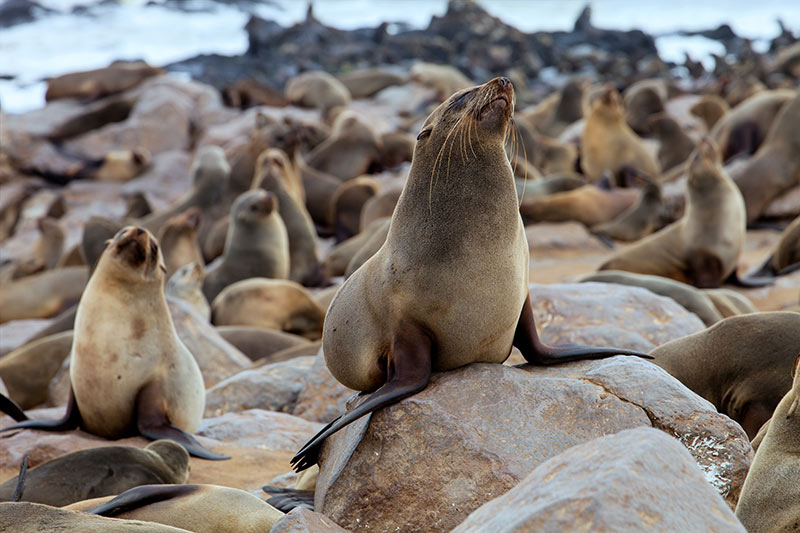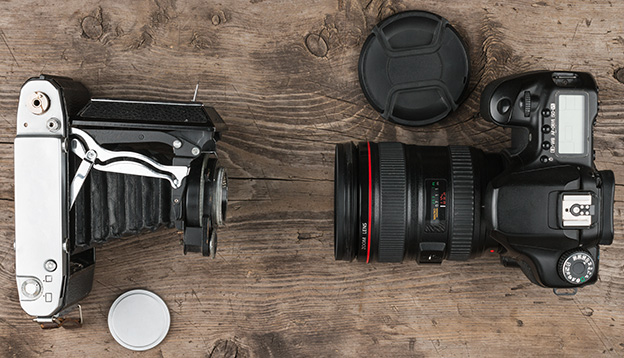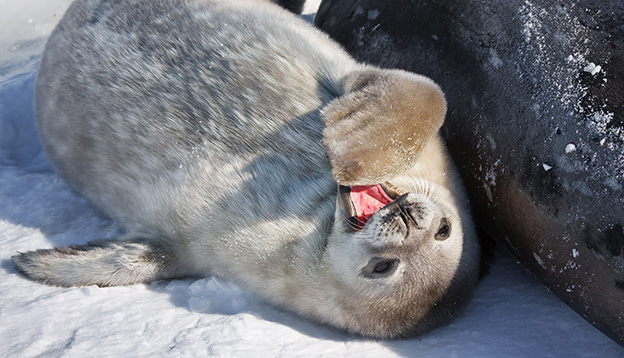Antarctica Photography: 11 Essential Tips
From the right gear to pack to how best to care for it and the most trusted techniques to capture the overwhelming beauty of Antarctica – we’ve got the best tips from the experts.
When it comes to photography, Antarctica is one of those curious conundrums. Here is undoubtedly one of the most photogenic places on earth yet, amidst the blinding white horizons and fast-moving wildlife (you know, aside from the elephant seals), here is also one of the hardest places to photograph. But, if you're seeking Antarctica photography tips, you've come to the right place!
Between the overwhelming glare, the sea spray when jetting about on zodiacs and the rather fresh temperature which can cause havoc on equipment (not to mention the mind-boggling size of everything which is sometimes difficult to portray) Antarctica is both a photographer’s dream and one its most challenging subject.
How do you combat all the hurdles, you wonder? With some expert photography tips for Antarctica!
1. Protect your precious gear
The following tips will be all but useless if your photographic equipment fails to work so, your first priority will be to secure your expensive gear. It may be fine if you're freezing for an hour or two when exploring the shores of Antarctica but your camera can’t just ‘suffer through it’ to make you happy: salt-water spray and freezing winds may simply shut it all down.
Make sure your gear is in a waterproof zip-up case and keep every item stored separately in its own Ziplock bag. That way, nothing will accidentally get wet as you open the bag to take out gear.
Moreover, it’s wise to place some moisture absorption pads in every separate bag as the disparity in temperature between the frigid Antarctica outdoors and your warm and cosy ship cabin, will likely result in moisture build-up. Interestingly enough, photographic equipment can cope quite well with 0-degrees-C if stored correctly; what it can’t cope with is being shuffled between cold and warm environments.
2. Steer clear of the point & shoot – they just won’t get the job done in Antarctica
Whilst it’s true that there are plenty of fantastic point & shoot cameras on the market today (heck, even mobile phones) that take unbelievable photos, they usually fail to hit the spot in Antarctica. Here, among the wild white horizons of ice, penguins and whales, you’ll want a wide-angle zoom and a 400mm telephoto lens, at the very least. You’ll be shooting amazing coves and wildlife from afar: not just from the ship’s outer decks but also from a respectable distance, on land.
You’ll want breathtaking close-ups of sunbathing seals and breaching whales, of waddling penguins and their entire, gobsmacking colonies. The beauty of Antarctica wildlife is that you can get quite close but, in order not to stress the animals, you will be asked to keep a safe distance. That’s where those lenses come in handy.
Much like African safaris, Antarctic expeditions offer you the chance to take some of your life’s very best nature photographs so always opt for a DSLR camera with interchangeable lenses.
That being said, they say the best camera is the one you have with you, so if you're travelling with just a mobile phone, don't stress - you're sure to still capture memories that you'll love.

3. Bring an extra camera body (of the same make)
Rather than waste precious time swapping lenses, it’s favourable to simply bring two camera bodies, if you can, each with its own distinct zoom – then just swap between cameras. That way, you can avoid the risk of switching lenses in bad weather, making it easier to switch between epic wide angle landscapes and wildlife close-ups.
4. Make sure you are familiar with your camera gear before attempting Antarctica photography
You know how the camera salesperson said ‘this camera is SO good even your 2-year-old can take National Geographic-quality pics?” He lied to you. Or, at the very least, grossly exaggerated – no camera is ever that good and, even the most expensive high-tech gizmos, will be almost useless with a less-than-apt operator. Whilst it’s totally valid to splurge on a great-quality mirrorless camera for your Antarctica voyage (because if not then, then when?) it is even more important that you know how to use it before you travel.
Invest in a workshop and get really comfy and intimate with your gear – we promise it will really show in your photos. If you’re still new to your camera, remember that you’ll have two full days to practice on it as you cross the Drake Passage.
Besides, even the slowest and laziest Antarctic wildlife is known to get super active just as you’re trying to figure out what the left-top button does. Be ‘at one’ with your gear before you travel to Antarctica and you’ll enjoy your photographic adventures even more.

5. Bring spares of everything – and then double up
The one photography tip for Antarctica you’ll read just about everywhere is that you should be ‘shooting relentlessly’ in times of wildlife action given that, as opposed to the good old days of film photography, our modern digital world allows for such extravagances. The only way you can really do that, however, is by bringing plenty of spares of EVERYTHING.
You’ll no doubt be taking infinitely more photos on an Antarctica expedition than on almost any other adventure out there and you simply won’t have time during the day to recharge the camera and download your photos onto your laptop, so carrying spare batteries and empty SD cards will save the day. You can easily set up your camera to download photos whilst you’re having dinner and leave the gear to charge overnight.
6. The most stunning wildlife photographs are taken at the subject’s eye-level
Don’t be scared to bend down or get into ridiculous positions just so you can be eye-to-eye with a magnificent Antarctic beast – this usually makes for the most arresting photos, especially if you manage to make eye contact. Just keep in mind the IAATO requirements for wildlife safety, noting you won't be able to sit or lie down on the snow or rocks.
But, if your shot works…it’s pure Antarctic photography magic.

7. Mind the glare: move around until you find the right light
One of the biggest photographic challenges of high-season Antarctic cruising is that the sun seems to be omnipresent, often washing out the landscapes/wildlife and causing a lot of overexposure. When it comes to wildlife, you’ll need to move around slowly so as not to disturb it yet as far as landscapes are concerned, you may have to walk for a few minutes to capture the scene from a totally different angle.
For this reason, the early and late Antarctica cruising months are preferable for photography: not only will you enjoy exquisite sunsets and sunrises but you’ll also enjoy particularly favourable lighting, all day long.
It’s a great idea to pack at least two filters: one UV-protection (for your lens) and one polarizing filter to specifically help tone down glare. Just do keep in mind that polarizing filters do darken everything: fine for a landscape shot on a glistening sunny day, not so fine on a black and white penguin.

8. Put subjects in perspective
Just as an Antarctic penguin is even more breathtaking if you can capture its relative grandeur by having a person in the shot, a gargantuan glacier is always more impressive if it’s captured with a kayaker meandering alongside it.
9. Don’t put your subject smack bang in the centre of the frame
A common Antarctica photography trick is to place the desired subject either in the left or right side of the frame when shooting horizontally leaving the rest of the frame to soak up the landscape. Unless you’re taking a super close up photo, your pic will be much more impressive if the subject is off-centre.

10. Be mindful of the background
Antarctica may be a contemplative and eerily quiet place but, when you’re onshore exploring landing sites and wildlife colonies, it can certainly be quite a hectic scene. Be mindful of background ‘noise’ when photographing a subject: it’s easy to get carried away when you spot your very first penguin to notice the fellow visitor, in the background, with the bright red jacket.
Rather than yell to your shipmate to ‘shove over just an inch’ it’s best to move around gently so you capture the beast without anyone else captured ‘behind the scenes’.

11. Never use the flash
Very few decent photos are ever taken with a flash in Antarctica and, as far as wildlife is concerned, it can be incredibly disturbing so make sure to never activate the flash. If you’re casting your eyes on a magnificent scene that just seems unfit to photograph without a flash then why not sit back, put your camera away and simply enjoy the startling spectacle?
Sometimes, in Antarctica, the most awe-inspiring moments are the ones that can’t be captured.
Which cruise line is best for Antarctica if I enjoy photography?
Photography enthusiasts are best suited to small expedition ships, as they maximise your opportunities for getting off the ship and onto the ice! With twice daily shore landings and zodiac cruises, you'll have ample opportunity for photography.
We specialise in small ships of 200 passengers or less, as they allow travellers more time on land. For more personalised help in choosing the right cruise, contact Chimu Adventures today.

Frequently Asked Questions
Q1. What telephoto zoom lens is best for an Antarctica cruise?
Telephoto zoom lenses can be useful for wildlife photography. Popular focal lengths include 70-200mm or 100-400mm.
Q2. Are there professional photographers onboard Antarctic cruises?
Yes, most expedition cruises have a photographer on staff and their images are shared with guests at no additional charge. Some voyages may also offer onboard educational photography workshops.
Q3. Can I rent photography equipment for my Antarctica cruise?
Yes, depending on your location, you may prefer the convenience of renting photography gear. This can be much more affordable than purchasing outright and is a good way to sample new lenses before buying.
Q4. Which part of Antarctica is best for photography?
All regions of Antarctica visited on an expedition cruise, including the Peninsula and South Georgia, are a dream for photography. Each day brings diverse wildlife, sculptural icebergs, and unique landscapes.
Q5. Can I fly my drone in Antarctica?
The short answer is no.
Why? Drones can disrupt wildlife and compromise the pristine environment we’re committed to preserving.
While drones may be used for scientific research or approved commercial projects, these activities require strict permits. Guests are not allowed to fly drones under any circumstances.
Where Will You Go Next ?
- Popular Destinations
- Antarctica
- The Arctic
- South America
- Central America
- More to explore
- Amazon
- Antarctic Circle
- Antarctic Peninsula
- Argentina
- Bolivia
- Brazil
- Canadian Arctic
- Chile
- Colombia
- Costa Rica & Panama
- East Antarctica
- Ecuador
- Galapagos Islands
- Greenland
- Guatemala & Honduras
- Machu Picchu
- Mexico
- Patagonia
- Peru
- South Georgia and Falkland Islands
- Spitsbergen
- Sub Antarctic Islands

Talk to one of our experienced Destination Specialists to turn your Antarctic, Arctic and South American dream into a reality.
Contact us
